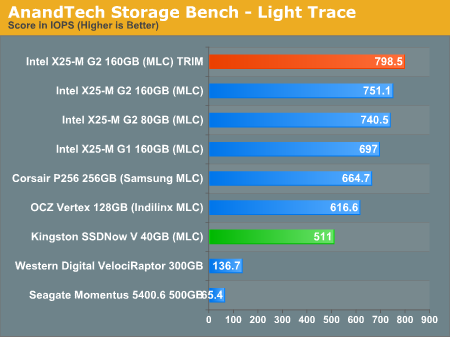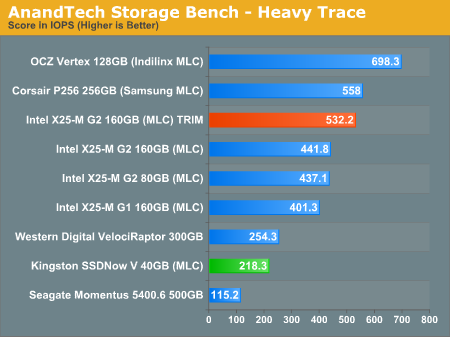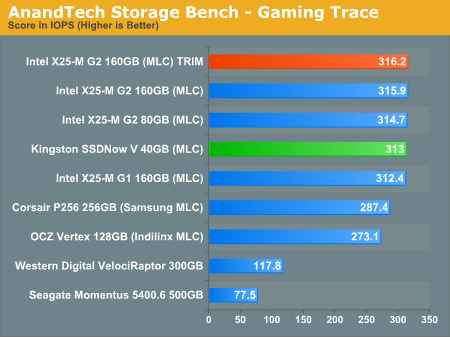The SSD Improv: Intel & Indilinx get TRIM, Kingston Brings Intel Down to $115
by Anand Lal Shimpi on November 17, 2009 7:00 PM EST- Posted in
- Storage
Introducing the AnandTech Storage Bench - Real World Performance Testing
Finding good, real world, storage benchmarks is next to impossible. The synthetic tests work up to a certain point but you need real world examples. Measuring performance in individual applications often ends up with charts like these where all of the drives perform identically. Benchmark suites like PCMark Vantage are the best we can do, but they are a bit too easy on these drives in my opinion and while representative of a real world environment, they aren’t necessarily representative of all real world environments.
Recently we’ve been able to get our hands on a piece of software that allows us to record all disk activity on a machine and then play it back on any other machine. The point is that we can now model a real world usage scenario without waiting for BAPCo or Futuremark to do it for us.
Our benchmarks debut here, today, and we’re starting with three. We haven’t had time to run all of the SSDs through this new suite so we’ll start with an abridged list.
The first in our new benchmark suite is a light usage case. The Windows 7 system is loaded with Firefox, Office 2007 and Adobe Reader among other applications. With Firefox we browse web pages like Facebook, AnandTech, Digg and other sites. Outlook is also running and we use it to check emails, create and send a message with a PDF attachment. Adobe Reader is used to view some PDFs. Excel 2007 is used to create a spreadsheet, graphs and save the document. The same goes for Word 2007. We open and step through a presentation in PowerPoint 2007 received as an email attachment before saving it to the desktop. Finally we watch a bit of a Firefly episode in Windows Media Player 11.
There’s some level of multitasking going on here but it’s not unreasonable by any means. Generally the application tasks proceed linearly, with the exception of things like web browsing which may happen in between one of the other tasks.
The recording is played back on all of our drives here today. Remember that we’re isolating disk performance, all we’re doing is playing back every single disk access that happened in that ~5 minute period of usage. The light trace is composed of 37,501 reads and 20,268 writes. Over 30% of the IOs are 4KB, 11% are 16KB, 22% are 32KB and approximately 13% are 64KB in size. Less than 30% of the operations are absolutely sequential in nature. Average queue depth is 6.09 IOs.
The performance results are reported in I/O Operations per Second (IOPS):

The hard drives set the minimum level of expectations here, the VelociRaptor only manages 137 IOPS. The fastest SSD is the X25-M G2 with the TRIM firmware installed at nearly 800 IOPS. The improvement over the older firmware is 6.25% thanks to the higher sequential write speed. The G2 is a bit faster than the G1 here, but what’s most interesting is how well the competing SSDs do.
Corsair’s P256 based on the Samsung RBX controller is very close to the performance of Intel’s X25-M G1 at 664 IOPS. It even outperforms the Indilinx MLC based OCZ Vertex by around 8%.
The Kingston 40GB drive is hampered by its small amount of free space. The actual benchmark takes up around 33GB of space, leaving very little breathing room for the baby SSD. That being said, the hopefully $85 bugger is nearly 4x the speed of a VelociRaptor.
If there’s a light usage case there’s bound to be a heavy one. In this test we have Microsoft Security Essentials running in the background with real time virus scanning enabled. We also perform a quick scan in the middle of the test. Firefox, Outlook, Excel, Word and Powerpoint are all used the same as they were in the light test. We add Photoshop CS4 to the mix, opening a bunch of 12MP images, editing them, then saving them as highly compressed JPGs for web publishing. Windows 7’s picture viewer is used to view a bunch of pictures on the hard drive. We use 7-zip to create and extract .7z archives. Downloading is also prominently featured in our heavy test; we download large files from the Internet during portions of the benchmark, as well as use uTorrent to grab a couple of torrents. Some of the applications in use are installed during the benchmark, Windows updates are also installed. Towards the end of the test we launch World of Warcraft, play for a few minutes, then delete the folder. This test also takes into account all of the disk accesses that happen while the OS is booting.
The benchmark is 22 minutes long and it consists of 128,895 read operations and 72,411 write operations. Roughly 44% of all IOs were sequential. Approximately 30% of all accesses were 4KB in size, 12% were 16KB in size, 14% were 32KB and 20% were 64KB. Average queue depth was 3.59.

While I appreciate that Intel improved sequential write speed a bit in the 160GB G2 drives, the heavy trace results show us that it’s not enough. The improvement to the 160GB G2 is tremendous, over 20%. But that only brings the 160GB G2 up to the performance of the Corsair P256 (Samsung RBX). The real winner here is the Indilinx based OCZ Vertex. At nearly 700 IOPS it has the right balance of random and sequential read/write speed for our heavy usage scenario. To quote from the Relapse:
“When I started writing this article I took a big step. I felt that Indilinx drives had reached the point that their performance was good enough to be considered an Intel alternative. I backed up my X25-M, pulled it out, and swapped in an OCZ Vertex drive - into my personal work system. I've been using it ever since and I must admit, I am happy. Indilinx has done it, these drives are fast, reliable (provided that you don't upgrade to the latest firmware without waiting a while) and are good enough.”
This is more than good enough, this is faster than Intel.
Unfortunately Intel has assured me that there’s no additional write speed left on the table for the X25-M G2. We’ll have to wait for the G3 next year to see that addressed.
Kingston’s very low sequential write speed hurts it the most here, the drive actually delivers performance lower than that of a VelociRaptor (although not by much). To be honest, this is a bit of an unfair test for the 40GB drive. It’s far too intense for what would ultimately be an apps/OS drive, but it does highlight the 40GB drive's weakpoints.
Our final test focuses on actual gameplay in four 3D games: World of Warcraft, Batman: Arkham Asylum, FarCry 2 and Risen, in that order. The games are launched and played, altogether for a total of just under 30 minutes. The benchmark measures game load time, level load time, disk accesses from save games and normal data streaming during gameplay.
The gaming trace is made up of 75,206 read operations and only 4,592 write operations. Only 20% of the accesses are 4KB in size, nearly 40% are 64KB and 20% are 32KB. A whopping 69% of the IOs are sequential, meaning this is predominantly a sequential read benchmark. The average queue depth is 7.76 IOs.

The gaming test is almost entirely reads and thus the Intel drives have no weaknesses. The G2s, G1s, TRIM or not, all perform about the same here. They’re about 10% faster than Samsung and 15% faster than Indilinx. Even the 40GB Kingston does just as well here.










162 Comments
View All Comments
RAWIRON - Saturday, December 19, 2009 - link
I've read about some Macbook hacks for the SSD user, but still wonder how I should make my SSD's "new" state last longer.I do still wonder if I should use the "Secure Empty Trash" in Snow Leopard? At first, I've partitioned my drive for all available space, but then reduced the HFS partition to 68 Gb or so - will this prolong my drive's "new" state because of Intel's algorithms?
Should I use "Erase Free Space" in Disk Utility?
Thanks!
kunedog - Saturday, December 26, 2009 - link
I would say NO. Secure Erase (of used or free space) will generate (many) more writes which can only make the problem worse, "using up" your reserve space much more quickly than before. At least that's what my intuition says. Maybe somenoe who knows for sure will chime in.kunedog - Friday, December 4, 2009 - link
The Kingston 40GB is available for $130:http://www.newegg.com/Product/Product.aspx?Item=N8...">http://www.newegg.com/Product/Product.aspx?Item=N8...
I wonder how many, if any, were sold at $85 (or even $115). I also wonder how this article is repeatedly bumped for minor (and predictable) updates while the incorrect pricing predictions are never acknowledged. The Intel MLC SSDs continue to list for much higher than the given "expected" launch price . . .
http://www.anandtech.com/storage/showdoc.aspx?i=36...">http://www.anandtech.com/storage/showdoc.aspx?i=36...
. . . yet that article was never bumped to the top. Even the G1s were priced higher! Props to Anand for keeping the SSD companies honest on performance, but why can't the same be done for pricing?
If I were going to release/retail a new SSD, I would definitely call Anand ahead of time and tell him an expected price about 50-75% of the real one so he would blindly print it and create demand.
mohsh86 - Thursday, December 3, 2009 - link
lol the promised to deliver it by the end of Novmber, they didn't but they changed the date of release :P i've been checking every day..The Firmware Update tool 1.5 is now available, posted (according to intel in 30/11) the SSD toolbox still unavailable..
did any one try it ?!
i have the firmware the one before the bricking firmware, i guess it has the letter g, should i upgrade ?!
mohsh86 - Tuesday, December 1, 2009 - link
It finally came ! The End of November, The 1st of December..No Trim Firmware, No Intel SSD Toolbox, no RAID support for toolbox
Dverez - Tuesday, December 1, 2009 - link
The new Firmware is out and works properly.To test SSD this is a good program, I think.
(http://alex-is.de/PHP/fusion/downloads.php?cat_id=...
mohsh86 - Tuesday, December 1, 2009 - link
It finally came ! The End of November, The 1st of December..No Trim Firmware, No Intel SSD Toolbox, no RAID support for toolbox
Sind - Monday, November 30, 2009 - link
Wheres the firmware update, it's Nov 30th!xpclient - Wednesday, November 25, 2009 - link
Please test 2 X25-Ms with Intel Matrix RAID10 and other Matrix RAID arrays the moment Intel drivers with TRIM come out.Mygaffer - Tuesday, November 24, 2009 - link
Another great article, thank you for all the hard work and insightful analysis. Articles like yours help keep the industry honest and responsive.I can't wait until they become cheap enough for me to buy two for a RAID 0, and of course for Intel to release new drivers to support the TRIM commands.